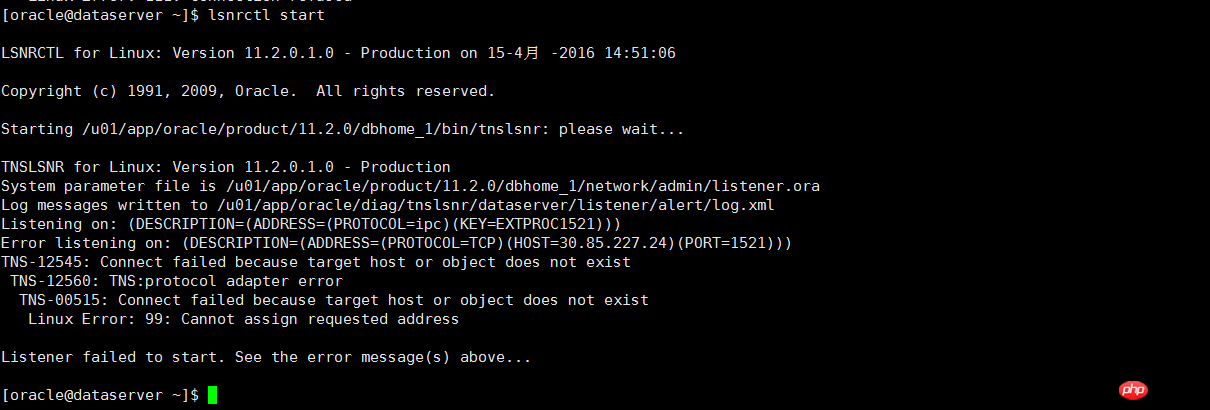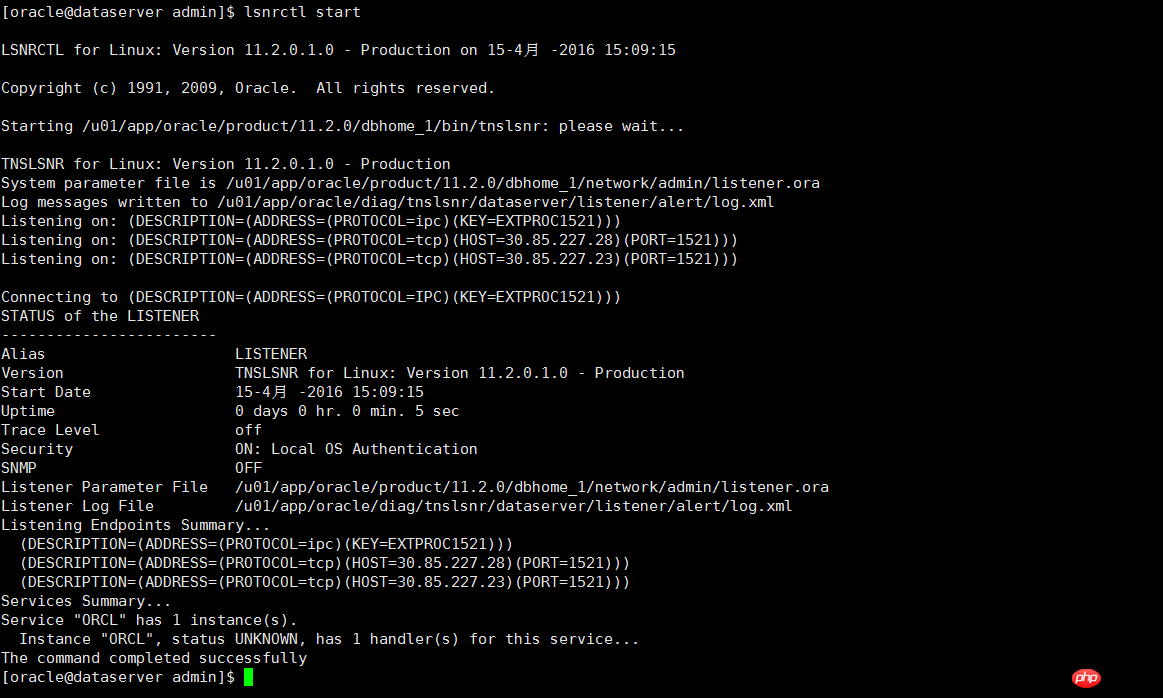How to start Oracle under Linux
This article mainly shares with you how to start Oracle under Linux, hoping to help everyone.
1. Steps to start Oracle
Starting Oracle under Linux is divided into the following two steps:
1.1. Start lsnrctl monitoring.
#1.2. Start the database instance.
2. Start oracle monitoring
First log in to the server and switch to oracle user.
<span style="font-family: 微软雅黑, "Microsoft YaHei"; font-size: 14px;">[admin@dataserver ~]$ su - oracle<br/>密码:<br/>[oracle@dataserver ~]$<br/></span>

Next, check the running status of the oracle listener and view it through the lsnrctl status command.
If the oracle monitoring is not started, execute the following to start monitoring, pass the command lsnrctl start, the results are as follows:

Above The feedback is that the monitoring startup failed because the IP 30.85.227.24 it is monitoring is not the IP of the server, so this IP needs to be adjusted to the current IP of the server.
Under the oracle user, enter the directory /u01/app/oracle/product/11.2.0/dbhome_1/network/admin and modify the listener.ora file. Note that this directory varies depending on the specific server. 
listener.ora file opens. The content is as follows. Just adjust the HOST IP in it.
After adjusting the listening IP, restart the listener and execute lsnrctl start
At this point, the oracle listener is started successfully!

3. Start the oracle instance
Log in to oracle as the system user
<span style="font-family: 微软雅黑, "Microsoft YaHei"; font-size: 14px;">[oracle@dataserver admin]$ sqlplus /nolog<br/><br/>SQL*Plus: Release 11.2.0.1.0 Production on 星期五 4月 15 15:23:04 2016<br/>Copyright (c) 1982, 2009, Oracle. All rights reserved.<br/><br/>SQL> conn as sysdba<br/>Enter user-name: system<br/>Enter password: <br/>Connected to an idle instance.0<br/></span>
Then start the instance through the startup command:
<span style="font-family: 微软雅黑, "Microsoft YaHei"; font-size: 14px;">SQL> startup<br/>ORACLE instance started.<br/><br/>Total System Global Area 4.0620E+10 bytes<br/>Fixed Size 2216024 bytes<br/>Variable Size 2.3354E+10 bytes<br/>Database Buffers 1.7180E+10 bytes<br/>Redo Buffers 84054016 bytes<br/>Database mounted.<br/>Database opened.<br/>SQL> <br/><br/></span>
4. Close the oracle instance
Through shutdown Command to shut down the oracle instance.
<span style="font-family: 微软雅黑, "Microsoft YaHei"; font-size: 14px;">SQL> shutdown<br/>Database closed.<br/>Database dismounted.<br/>ORACLE instance shut down.<br/>SQL> <br/></span>
The above is the detailed content of How to start Oracle under Linux. For more information, please follow other related articles on the PHP Chinese website!

Hot AI Tools

Undresser.AI Undress
AI-powered app for creating realistic nude photos

AI Clothes Remover
Online AI tool for removing clothes from photos.

Undress AI Tool
Undress images for free

Clothoff.io
AI clothes remover

Video Face Swap
Swap faces in any video effortlessly with our completely free AI face swap tool!

Hot Article

Hot Tools

Notepad++7.3.1
Easy-to-use and free code editor

SublimeText3 Chinese version
Chinese version, very easy to use

Zend Studio 13.0.1
Powerful PHP integrated development environment

Dreamweaver CS6
Visual web development tools

SublimeText3 Mac version
God-level code editing software (SublimeText3)

Hot Topics
 1673
1673
 14
14
 1428
1428
 52
52
 1333
1333
 25
25
 1277
1277
 29
29
 1257
1257
 24
24
 Linux Architecture: Unveiling the 5 Basic Components
Apr 20, 2025 am 12:04 AM
Linux Architecture: Unveiling the 5 Basic Components
Apr 20, 2025 am 12:04 AM
The five basic components of the Linux system are: 1. Kernel, 2. System library, 3. System utilities, 4. Graphical user interface, 5. Applications. The kernel manages hardware resources, the system library provides precompiled functions, system utilities are used for system management, the GUI provides visual interaction, and applications use these components to implement functions.
 How to check the warehouse address of git
Apr 17, 2025 pm 01:54 PM
How to check the warehouse address of git
Apr 17, 2025 pm 01:54 PM
To view the Git repository address, perform the following steps: 1. Open the command line and navigate to the repository directory; 2. Run the "git remote -v" command; 3. View the repository name in the output and its corresponding address.
 Oracle's Role in the Business World
Apr 23, 2025 am 12:01 AM
Oracle's Role in the Business World
Apr 23, 2025 am 12:01 AM
Oracle is not only a database company, but also a leader in cloud computing and ERP systems. 1. Oracle provides comprehensive solutions from database to cloud services and ERP systems. 2. OracleCloud challenges AWS and Azure, providing IaaS, PaaS and SaaS services. 3. Oracle's ERP systems such as E-BusinessSuite and FusionApplications help enterprises optimize operations.
 How to run java code in notepad
Apr 16, 2025 pm 07:39 PM
How to run java code in notepad
Apr 16, 2025 pm 07:39 PM
Although Notepad cannot run Java code directly, it can be achieved by using other tools: using the command line compiler (javac) to generate a bytecode file (filename.class). Use the Java interpreter (java) to interpret bytecode, execute the code, and output the result.
 How to run sublime after writing the code
Apr 16, 2025 am 08:51 AM
How to run sublime after writing the code
Apr 16, 2025 am 08:51 AM
There are six ways to run code in Sublime: through hotkeys, menus, build systems, command lines, set default build systems, and custom build commands, and run individual files/projects by right-clicking on projects/files. The build system availability depends on the installation of Sublime Text.
 laravel installation code
Apr 18, 2025 pm 12:30 PM
laravel installation code
Apr 18, 2025 pm 12:30 PM
To install Laravel, follow these steps in sequence: Install Composer (for macOS/Linux and Windows) Install Laravel Installer Create a new project Start Service Access Application (URL: http://127.0.0.1:8000) Set up the database connection (if required)
 git software installation
Apr 17, 2025 am 11:57 AM
git software installation
Apr 17, 2025 am 11:57 AM
Installing Git software includes the following steps: Download the installation package and run the installation package to verify the installation configuration Git installation Git Bash (Windows only)
 MongoDB vs. Oracle: Choosing the Right Database for Your Needs
Apr 22, 2025 am 12:10 AM
MongoDB vs. Oracle: Choosing the Right Database for Your Needs
Apr 22, 2025 am 12:10 AM
MongoDB is suitable for unstructured data and high scalability requirements, while Oracle is suitable for scenarios that require strict data consistency. 1.MongoDB flexibly stores data in different structures, suitable for social media and the Internet of Things. 2. Oracle structured data model ensures data integrity and is suitable for financial transactions. 3.MongoDB scales horizontally through shards, and Oracle scales vertically through RAC. 4.MongoDB has low maintenance costs, while Oracle has high maintenance costs but is fully supported.




